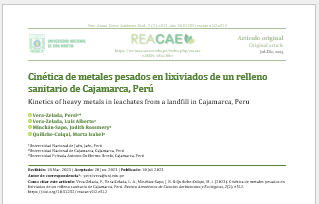Cinética de metales pesados en lixiviados de un relleno sanitario de Cajamarca, Perú
DOI:
https://doi.org/10.51252/reacae.v2i2.512Palabras clave:
biodigestión anaeróbica, metales, tratamiento de lixiviadosResumen
Esta investigación propuso determinar la cinética de metales tóxicos del lixiviado de la infraestructura de tratamiento y disposición final de residuos sólidos de Cajamarca al entrar en contacto con el suelo. El estudio se ejecutó a nivel de laboratorio; se colocó en un recipiente de 150 L, 100 kg de suelo y un volumen de 60 L de lixiviado para generar el contacto de ambos, el experimento duró 60 días y se muestreo cada 10 días en los siguientes lapsos de 0, 10, 20, 30, 40 y 50 días para luego ser recirculado. El lixiviado no aporta contaminantes al suelo, el suelo se comporta con un adsorbente puesto que el arsénico, el cadmio, el cromo, el hierro, el plomo y el zinc, son metales retenidos o adsorbidos en adición, el cobre y el mercurio son metales que el suelo no retiene. Con respecto a la cinética, se demostró que la velocidad de reacción del hierro es mayor a los demás con 0,012 mg/días y una adecuación promedio de todos los metales al modelo de pseudo segundo orden del 99,58%. Se concluye que los metales tóxicos del lixiviado tienen una baja velocidad de reacción en el suelo.
Descargas
Citas
Abdel-Shafy, H. I., & Mansour, M. S. M. (2018). Solid waste issue: Sources, composition, disposal, recycling, and valorization. Egyptian Journal of Petroleum, 27(4), 1275–1290. https://doi.org/10.1016/j.ejpe.2018.07.003
Cárdenas-Ferrer, T. M., Santos-Herrero, R. F., Contreras-Moya, A. M., Rosa-Domínguez, E., & Correa-Cortés, Y. (2020). Diseño de una planta para el tratamiento del lixiviado en Vertedero de Sagua La Grande. Tecnología Química, 40(2). http://scielo.sld.cu/scielo.php?script=sci_arttext&pid=S2224-61852020000200413&lng=es&tlng=es
Chowdhury, S., Bolan, N., Farrell, M., Sarkar, B., Sarker, J. R., Kirkham, M. B., Hossain, M. Z., & Kim, G.-H. (2021). Role of cultural and nutrient management practices in carbon sequestration in agricultural soil (pp. 131–196). https://doi.org/10.1016/bs.agron.2020.10.001
Dai, J., Ren, F., & Tao, C. (2012). Adsorption Behavior of Fe(II) and Fe(III) Ions on Thiourea Cross-Linked Chitosan with Fe(III) as Template. Molecules, 17(4), 4388–4399. https://doi.org/10.3390/molecules17044388
Jayawardhana, Y., Kumarathilaka, P., Herath, I., & Vithanage, M. (2016). Municipal Solid Waste Biochar for Prevention of Pollution From Landfill Leachate. In Environmental Materials and Waste (pp. 117–148). Elsevier. https://doi.org/10.1016/B978-0-12-803837-6.00006-8
Kapelewska, J., Kotowska, U., & Wiśniewska, K. (2016). Determination of personal care products and hormones in leachate and groundwater from Polish MSW landfills by ultrasound-assisted emulsification microextraction and GC-MS. Environmental Science and Pollution Research, 23(2), 1642–1652. https://doi.org/10.1007/s11356-015-5359-9
Li, K., Zheng, Z., Huang, X., Zhao, G., Feng, J., & Zhang, J. (2009). Equilibrium, kinetic and thermodynamic studies on the adsorption of 2-nitroaniline onto activated carbon prepared from cotton stalk fibre. Journal of Hazardous Materials, 166(1), 213–220. https://doi.org/10.1016/j.jhazmat.2008.11.007
Meshram, P., Pandey, B. D., & Mankhand, T. R. (2016). Process optimization and kinetics for leaching of rare earth metals from the spent Ni–metal hydride batteries. Waste Management, 51, 196–203. https://doi.org/10.1016/j.wasman.2015.12.018
Peng, Y. (2017). Perspectives on technology for landfill leachate treatment. Arabian Journal of Chemistry, 10, S2567–S2574. https://doi.org/10.1016/j.arabjc.2013.09.031
Propp, V. R., De Silva, A. O., Spencer, C., Brown, S. J., Catingan, S. D., Smith, J. E., & Roy, J. W. (2021). Organic contaminants of emerging concern in leachate of historic municipal landfills. Environmental Pollution, 276, 116474. https://doi.org/10.1016/j.envpol.2021.116474
PUCP. (2016). ¿Sabías que Perú genera 18 131 toneladas de basura al día? Clima de Cambios PUCP. https://www.pucp.edu.pe/climadecambios/noticias/sabias-que-peru-genera-18-131-toneladas-de-basura-al-dia/#:~:text=“ElPerúestágenerando18,residuossólidosdelINTE–PUCP
Puga, S. (2006). Contaminación por metales pesados en suelo provocada por la industria minera: Heavy metals pollution in soils damaged by mining industry. Ecología Aplicada, 5(1–2), 149–155. http://www.scielo.org.pe/scielo.php?pid=S1726-22162006000100020&script=sci_abstract
Sasakova, N., Gregova, G., Takacova, D., Mojzisova, J., Papajova, I., Venglovsky, J., Szaboova, T., & Kovacova, S. (2018). Pollution of Surface and Ground Water by Sources Related to Agricultural Activities. Frontiers in Sustainable Food Systems, 2. https://doi.org/10.3389/fsufs.2018.00042
Wuana, R. A., & Okieimen, F. E. (2011). Heavy Metals in Contaminated Soils: A Review of Sources, Chemistry, Risks and Best Available Strategies for Remediation. ISRN Ecology, 2011, 1–20. https://doi.org/10.5402/2011/402647

Publicado
Cómo citar
Número
Sección
Licencia
Derechos de autor 2023 Persi Vera-Zelada , Luis Alberto Vera-Zelada, Judith Rossmery Minchán-Sapo , Marta Isabel Quiliche-Culqui

Esta obra está bajo una licencia internacional Creative Commons Atribución 4.0.
Los autores retienen sus derechos:
a. Los autores retienen sus derechos de marca y patente, y tambien sobre cualquier proceso o procedimiento descrito en el artículo.
b. Los autores retienen el derecho de compartir, copiar, distribuir, ejecutar y comunicar públicamente el articulo publicado en la Revista Amazónica de Ciencias Ambientales y Ecológicas (REACAE) (por ejemplo, colocarlo en un repositorio institucional o publicarlo en un libro), con un reconocimiento de su publicación inicial en la REACAE.
c. Los autores retienen el derecho a hacer una posterior publicación de su trabajo, de utilizar el artículo o cualquier parte de aquel (por ejemplo: una compilación de sus trabajos, notas para conferencias, tesis, o para un libro), siempre que indiquen la fuente de publicación (autores del trabajo, revista, volumen, número y fecha).



